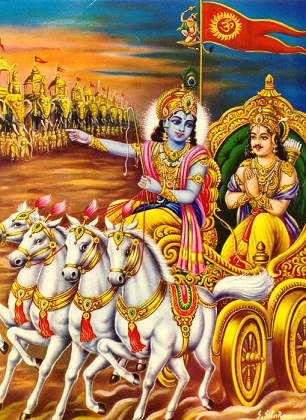Contribute
| The Annual Bhagvad Geeta Reading At Sri Lakshmi Temple |
Prof. Mahesh Sharma
09/22/2015
The Geeta parayan (yearly reading of The Bhagvad Geeta) took place on the occasion of Shri Krishna Janmashtami at the Sri Laxmi Temple in Ashland on Sunday, September 6, 2015. Begun in 1994, it is an effort to help popularize the scriptural text among the temple devotees. Dr. Bijoy Misra and Mrs. Ranjini Ramaswamy were the organizers. The Bhagvad Geeta In the Geeta, Master Yogi Lord Krishna, describes what is the nature of life and what it takes to make it meaningful. He explains a philosophy of living and ways of living it. For example, in the second chapter, the Great Teacher, Sri Krishna, gives us a preview of what is expected of us in the process of living this life and in the eighteenth chapter, what does that living looks life. In the intervening chapters, he shows different ways that people with diverse backgrounds, temperaments, behaviors, inclinations and needs can achieve the science of living and live a life without fear, worry, stress, and incompleteness. And, the Master Teacher, as he has done throughout the Celestial Song, aptly and deftly explains the meanings of these two terms and emphasizes that through tyaaga alone one can achieve the renunciation and one can live a full life.
The Pooja was conducted by the veteran priest, Shree Krishna Bhattacharya. He has been associated with the reading for many years. The temple extended all the facilities to make it happen. We are so thankful to the trustees and the management of the temple for providing the venue and support for this parayan every year.
Several people participated in the reading. The visitors to the temple were able to join for the reading and the final pooja and mingled with people to express their understanding of the Geeta. Being the long--weekend, the attendance at the parayan was less than expected. We hope in future we organize it so that more people are able to participate.
We see The Geeta at multiple levels: (a) A master piece of great literary tradition of a rich and vibrant culture, (b) a treatise on a school of systematic psychology and philosophy, and (c) a handbook of a way of living a full life.
In the early chapters, Sri Krishna, introduces the first important concept of the Geeta—sanyaas (renunciation), to introduce the students as a novice, he is so attached to the world and its seductions, and, therefore, is not able to achieve optimal outcomes from his actions. In western psychological terms, it is creating a state of cognitive dissonance. Because of the desire to focus on the results, one is not able to live the life fully—the future and the results cloud the current action itself and it results in unfulfilled life. Sanyaas is the renunciation of the attachment with the result and having a focus on the action—total attention to the present, and total absence of worry and stress by leaving the results to the future.
The desire behind the fruits of actions keeps us in bondage and full dedication on the action at hand without worrying about the outcome is freedom—true sanyaas. True action is an effort put forth in the present, which, in its time, will, it is hoped, fulfill itself in the desired fruit. And the fruit is what we reap later on as a result of the present action. Desire and agitation bring about restlessness, and deeper the desire, greater the amount of dissipation of our energies within. Such a dissipated man cannot execute any piece of work with study efficiency and true ardor.
In the chapter eighteen, Lord Krishna, takes up the theme of tyaaga (abandonment). On the surface, these two most important terms—the focus of the Gita--for an initiate look, sound, and appear similar. The ideal disciple, Arjuna, in spite of the whole discourse, asks a direct question in this chapter: What is the difference between sanyaas and tyaaga?
Through the teachings of the Geeta we can discover, in ourselves, the capacity to abandon from our mind its various unhealthy relationships with the world outside and habits of worry and stress and reeducate ourselves to be continuously vigilant and alert to live in that healthy, intelligent spirit of detachment (tyaaga). This calls for the total withering away of false ego, pretensions, and its endless desire-promptings, to achieve the true sanyaas.
You may also access this article through our web-site http://www.lokvani.com/

